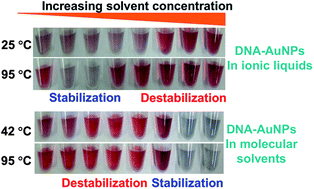Exploring the thermal stability of DNA-linked gold nanoparticles in ionic liquids and molecular solvents†
Abstract
While

* Corresponding authors
a
Department of Chemistry, Waterloo Institute for Nanotechnology, University of Waterloo, 200 University Avenue West, Waterloo, Ontario, Canada N2L 3G1
E-mail:
liujw@uwaterloo.ca
Fax: +1 519 746-0435
Tel: +1 519 888 746 4567 ext. 38919
While

 Please wait while we load your content...
Something went wrong. Try again?
Please wait while we load your content...
Something went wrong. Try again?
A. B. Menhaj, B. D. Smith and J. Liu, Chem. Sci., 2012, 3, 3216 DOI: 10.1039/C2SC20565C
To request permission to reproduce material from this article, please go to the Copyright Clearance Center request page.
If you are an author contributing to an RSC publication, you do not need to request permission provided correct acknowledgement is given.
If you are the author of this article, you do not need to request permission to reproduce figures and diagrams provided correct acknowledgement is given. If you want to reproduce the whole article in a third-party publication (excluding your thesis/dissertation for which permission is not required) please go to the Copyright Clearance Center request page.
Read more about how to correctly acknowledge RSC content.
 Fetching data from CrossRef.
Fetching data from CrossRef.
This may take some time to load.
Loading related content
